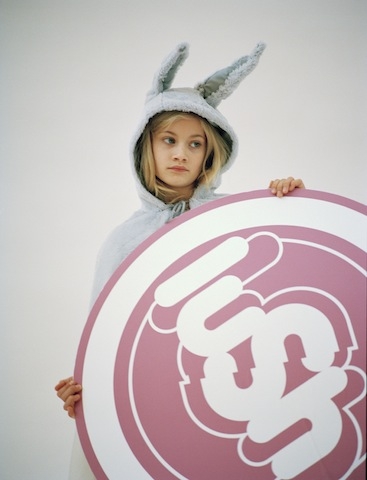From the street you can already see that Tobias Madison has adhered red foil to all of the windows of Kestnergesellschaft as part of his exhibition das blut, im fruchtfleisch gerinnend beim birnenbiss (which translates as ‘blood congealing in the flesh of a bitten pear’). As red is the trademark colour of the exhibition space, is this some sort of institutional critique? Or is the Swiss artist’s intervention perhaps playing on Kestnergesellschaft’s location in Hanover’s red-light district? In any case, the entire house is flooded in a seductive and sensual pale-red glow. This ambiguity between art and the wider world traverses this compelling exhibition like a red thread.
Inside, the exhibition begins in a room that again shows red-paned windows, this time not fitted into the wall but in the form of four square paintings of windows that Madison has hung on the wall. These red-painted window images do not allow one to see the world outside the white cube, and it’s precisely this impossibility that defines the artist’s interaction with the artworld. This hermetic insularity he criticises via these pseudo-windows, however, is reflected broadly across the spectrum of art; Madison knows that all artistic endeavours attempt to break out of the confines of this world, but ultimately land squarely within it. And so he opens parts of this gallery building – such as the delivery areas – that would normally be concealed from visitors. In various places his cleverly staged exhibition includes pallets holding bags of sand, hinting at the process of constructing his exhibition. Both are strategies we recognise from the history of institutional critique, yet here they are coupled with hybrid works of art that perpetuate Madison’s ambiguous game of high and common culture.
Aside from the reference to brothels, for example, one of the two main rooms of the gallery shows the facade of a ghost train. On one side of this readymade are the usual motifs – a medieval castle, a frightening skeleton and bloodthirsty mythic creatures – while the back side is a flat white surface, at once symbolising the return of the white cube within the exhibition and exposing the illusionistic character of the ghost train. Also referenced here is Vapour in Debri (2014), a work conceived with Emanuel Rossetti and Stefan Tcherepnin, and Elaine Sturtevant’s installation The House of Horror (2013), which she constructed for Hanover’s Sprengel Museum.
Passing through the backdrop of the ghost train, the visitor reaches a final room showing the exhibition’s title video, das blut, im fruchtfleisch gerinnend beim birnenbiss (2016). This work was created in collaboration with a range of fellow combatants, actors aged six to thirteen, who are attendees of a childcare centre in Hanover. (Tcherepnin contributed the music.) The video approximates a remake of Shūji Terayama’s experimental film Emperor Tomato Ketchup (1971), about children rebelling against the world of adults: a multilayered parable of leftwing groups in Japan in which the children, once assuming power, operate no less authoritatively than the deposed regime. Madison’s trashy remake, shot in amateurish DIY style, shifts the message to, if nothing else, a criticism of pedagogy. The children in the video ‘play’ more than ‘act’; they do their own thing. Heavy-handed directing was out of the question. Fun was the task. Here, then, the artist immerses himself in an intertextual discourse, and simultaneously couples his institutional critique with a critique of pedagogy. This matters because art pedagogy – educational programming aimed at integration into existing systems – is well known as a form of mediation that promises to lend societal acceptance to art in lieu of any genuine criticism. In this way, and twice over, Madison disavows the possibility of art really connecting with the world outside the gallery.
Kestnergesellschaft, Hanover, 6 February – 24 April 2016
This article first appeared in the April 2016 issue of ArtReview
